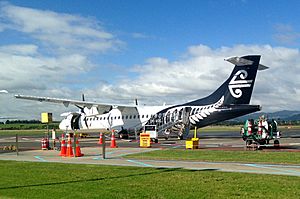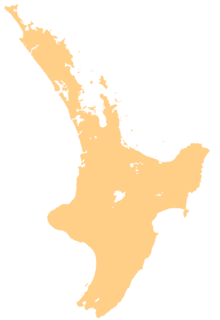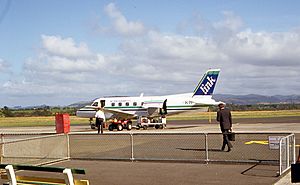Tauranga Airport facts for kids
Quick facts for kids
Tauranga Airport
|
|||||||||||||||||||||||
|---|---|---|---|---|---|---|---|---|---|---|---|---|---|---|---|---|---|---|---|---|---|---|---|

Aerial view of Tauranga Airport (2015)
|
|||||||||||||||||||||||
| Summary | |||||||||||||||||||||||
| Airport type | Public | ||||||||||||||||||||||
| Operator | Tauranga Airport Authority | ||||||||||||||||||||||
| Location | Tauranga | ||||||||||||||||||||||
| Elevation AMSL | 13 ft / 4 m | ||||||||||||||||||||||
| Coordinates | 037°40′24″S 176°11′50″E / 37.67333°S 176.19722°E | ||||||||||||||||||||||
| Website | http://taurangacityairport.co.nz/ | ||||||||||||||||||||||
| Map | |||||||||||||||||||||||
| Runway | |||||||||||||||||||||||
|
|||||||||||||||||||||||
| Statistics (2017) | |||||||||||||||||||||||
|
|||||||||||||||||||||||

Tauranga Airport (IATA: TRG, ICAO: NZTG) is an airport that serves the city of Tauranga, New Zealand. It is located next to Tauranga Harbour in the area called Mount Maunganui. This is about 3 kilometers northeast of Tauranga's main city center.
The airport building is on Jean Batten Drive, north of the runway. It has two floors and four gates where planes park. Air New Zealand flies to Tauranga using its smaller airlines, Mount Cook Airline and Air Nelson. They offer flights to Auckland, Wellington, and Christchurch. Other regional airlines also fly here. You can also find scenic flights, charter flights, skydiving, and general aviation (private planes) at the airport.
Contents
Airport History and Growth
Early Days and World War II
In 1935, the Tauranga Aero Club rented land near Tauranga Harbour. They wanted to build an airfield there. Before this, Tauranga only had a runway that could only be used when the tide was low. People realized a permanent airport was needed as the area grew.
The airport officially opened in 1939 with big celebrations. Later that same year, the Royal New Zealand Air Force took over the airport. This happened because World War II had started. During the war, the runways were made longer, and a hangar (a building for planes) was built. The airport was mainly used to train pilots.
Post-War Flights and Changes
The airport was given back to the Tauranga Aero Club in 1945. In 1946, the club started flying passengers from Tauranga to Motiti Island. Later, they added flights to Matakana Island. In 1947, a big airline called the New Zealand National Airways Corporation (NAC) began flying passengers to the airport.
From June 1966 to August 1967, the main runway was closed. It was being sealed with a new surface. During this time, larger planes, like those used by NAC, could not land there. Smaller planes from Adastra Aviation flew from Tauranga to Auckland and Rotorua. They used the airport's smaller runways.
When the sealing was finished in August 1967, NAC started using Fokker Friendship planes at Tauranga for the first time. In 1978, Air New Zealand took over passenger flights after joining with NAC.
Modern Upgrades and Expansion
In 1998, the airport, now owned by the Tauranga City Council, made its runway longer. It was extended to the east and reached its current length of 1,825 meters. In the years that followed, the airport building was made bigger and improved. A second floor was added, which included an Koru Club lounge and a meeting room.
In March 2000, Origin Pacific Airways started flights between Tauranga and Auckland. They used a 19-seat BAE Jetstream 32 plane. Later, this service changed to flights to Hamilton. Passengers could then connect to other Origin Pacific flights.
In June 2006, Origin Pacific Airways returned to Tauranga. They offered flights to Christchurch, which was the airport's first regular direct flight to the South Island. However, these flights stopped just two months later in August 2006.
In October 2007, Air New Zealand started flights to Christchurch. These flights were in addition to their existing flights to Auckland and Wellington. They used 50-seat Bombardier Q300 and 19-seat Beech 1900D planes.
In 2010, the airport expanded its terminal building again. This project took six months. It included bigger areas for checking in and baggage claim. The terminal grew by 830 square meters. The area where planes park was also expanded to fit a fourth plane overnight. In January 2013, Air New Zealand began using its Mount Cook Airlines, which flies 68-seat ATR 72 planes on some routes.
How Tauranga Airport Works
Air New Zealand is the main airline at Tauranga Airport. Its regional airlines, Mount Cook Airline and Air Nelson, use ATR 72 and Bombardier Q300 planes. They fly under the Air New Zealand Link brand. There are many flights each day to Auckland, Wellington, and Christchurch.
Tauranga Airport is also the main base for a regional airline called Sunair. Sunair has regular flights to places like Claris, Gisborne, North Shore, Motiti Island, Whangarei, and Whitianga. They use smaller planes like the 3-seat Cessna 172 Skyhawk and the 5-seat Piper PA23 Aztec.
Many companies offer scenic flights and charter flights from the airport. There are also skydiving, glider, and helicopter activities. A lot of private planes are kept at Tauranga Airport. Most of them are stored in hangars on the east and northwest sides of the terminal.
In 2017, Tauranga Airport was the tenth busiest airport in New Zealand for passenger numbers. It was the fifth busiest for the number of planes taking off and landing. It is the busiest airport in the Bay of Plenty region for both passengers and plane movements.
Since 2004, Tauranga Airport has hosted the Sportavex fly-in and airshow every two years. From 2010, this event became part of the larger Tauranga City Airshow. This airshow is run by the local Classic Flyers museum and is also known as Classics of the Sky.
Future Airport Plans
In 2006, a study looked into building a new airport. This new airport would be in Paengaroa or Pyes Pa. The idea was to serve both Tauranga and Rotorua and attract more flights, including international ones. However, the study found that Tauranga Airport could still handle more flights. Also, a new airport would be expensive and not in a convenient location. So, the idea was not pursued.
Airlines and Where They Fly
| Airlines | Destinations |
|---|---|
| Air New Zealand | Auckland, Christchurch, Wellington |
| Sunair | Claris, Gisborne, North Shore, Whangarei, Whitianga |
Passenger Numbers Over Time
| Year | Passengers | Aircraft Movements |
|---|---|---|
| 2016 | 292,998 | 65,628 |
| 2015 | 285,992 | 60,624 |
| 2014 | 273,857 | 58,448 |
| 2013 | 261,265 | 70,450 |
| 2012 | 248,519 | 72,652 |
| 2011 | 246,485 | 74,400 |
| 2010 | 238,398 | 86,935 |
| 2009 | 203,138 | 97,144 |
| 2008 | 199,468 | 105,992 |
| 2007 | 185,711 | 97,631 |
| 2006 | 170,311 | 94,207 |
| 2005 | 153,359 | 85,010 |
| 2004 | 141,924 | 77,521 |



